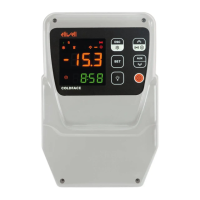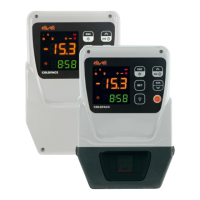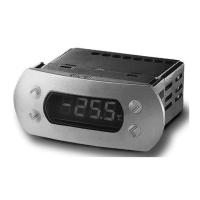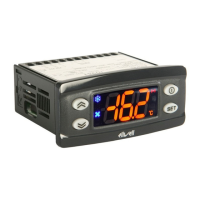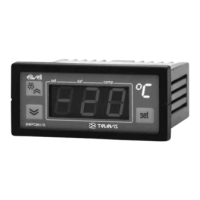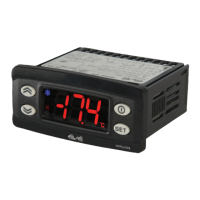Do you have a question about the Eliwell EWRC 300 NT and is the answer not in the manual?
Important safety precautions and general guidelines for electrical connections.
Specific warnings regarding power supply and dangerous voltage outputs.
Visual representation of the controller's wiring connections.
Table detailing the function of each terminal on the controller.
Wiring diagram specific to models with a magneto-thermal switch.
Terminal functions for models with magneto-thermal switch.
General guidance on installing the device in suitable environments.
Step-by-step instructions for mounting the controller on a wall.
How the controller manages the compressor based on temperature and functions.
Configuration of compressor relay and output association.
Protections and operating modes for the compressor and general outputs.
Safety times for compressor on-off operations, including delays.
Explanation of defrost and dripping functions to prevent ice formation.
How to select defrost type (electric, inverse, free) and activation methods.
How automatic defrost cycles are programmed and initiated.
Details on different defrost modes.
Configuration and operation of defrost using electric heaters.
Configuration and operation of hot gas defrost.
How to manage defrost for systems with two evaporators.
How the controller manages evaporator fans.
Regulator for pressure switch inputs and alarm handling.
Management of door switch inputs and external alarms.
Control and configuration of condenser fans.
Step-by-step guide to modify user parameters.
Step-by-step guide to edit installer level parameters.
Comprehensive table listing all controller parameters, their levels, and descriptions.
Table listing alarm codes, descriptions, and parameters involved.
Table detailing causes, effects, and remedies for various alarms.
Detailed descriptions of specific alarm types.
Explanation of probe errors (E1, E2, E3) and their actions.
Important safety precautions and general guidelines for electrical connections.
Specific warnings regarding power supply and dangerous voltage outputs.
Visual representation of the controller's wiring connections.
Table detailing the function of each terminal on the controller.
Wiring diagram specific to models with a magneto-thermal switch.
Terminal functions for models with magneto-thermal switch.
General guidance on installing the device in suitable environments.
Step-by-step instructions for mounting the controller on a wall.
How the controller manages the compressor based on temperature and functions.
Configuration of compressor relay and output association.
Protections and operating modes for the compressor and general outputs.
Safety times for compressor on-off operations, including delays.
Explanation of defrost and dripping functions to prevent ice formation.
How to select defrost type (electric, inverse, free) and activation methods.
How automatic defrost cycles are programmed and initiated.
Details on different defrost modes.
Configuration and operation of defrost using electric heaters.
Configuration and operation of hot gas defrost.
How to manage defrost for systems with two evaporators.
How the controller manages evaporator fans.
Regulator for pressure switch inputs and alarm handling.
Management of door switch inputs and external alarms.
Control and configuration of condenser fans.
Step-by-step guide to modify user parameters.
Step-by-step guide to edit installer level parameters.
Comprehensive table listing all controller parameters, their levels, and descriptions.
Table listing alarm codes, descriptions, and parameters involved.
Table detailing causes, effects, and remedies for various alarms.
Detailed descriptions of specific alarm types.
Explanation of probe errors (E1, E2, E3) and their actions.
| Type | Electronic Controller |
|---|---|
| Power Supply | 24 V AC/DC ±10% |
| Temperature Range (PTC) | -50°C to +150°C |
| Input Type | NTC, PTC, Pt100, Pt1000, TC J, TC K |
| Outputs | Relay |
| Operating Temperature | -10°C to +55°C |
| Accuracy | ±0.5% fs + 1 digit |
| Resolution | 0.1°C |
| Digital inputs | Up to 2 digital inputs |
| Serial communication | RS485 (optional) |
| Communication | Modbus RTU |
| Buzzer | Optional |
